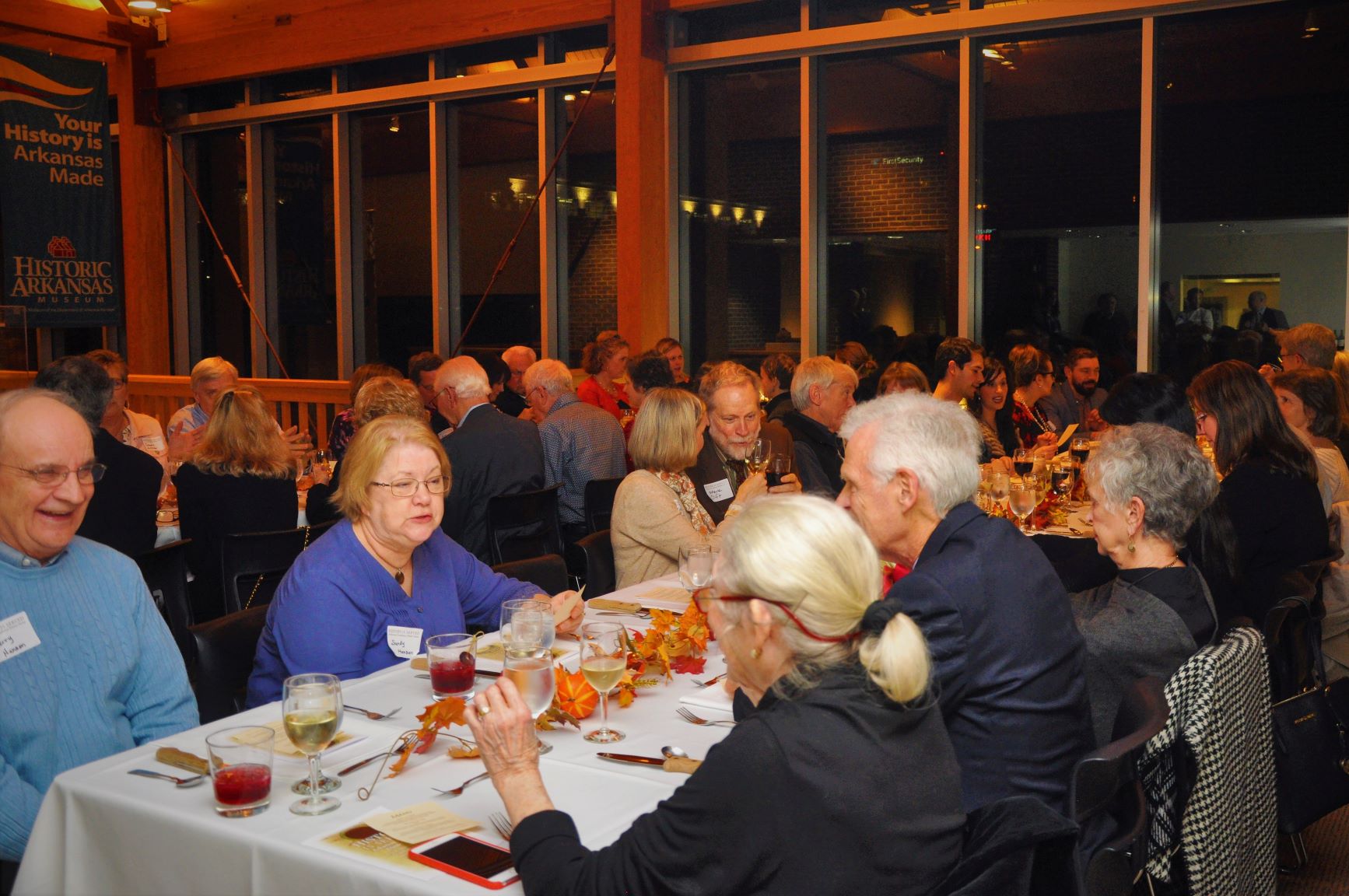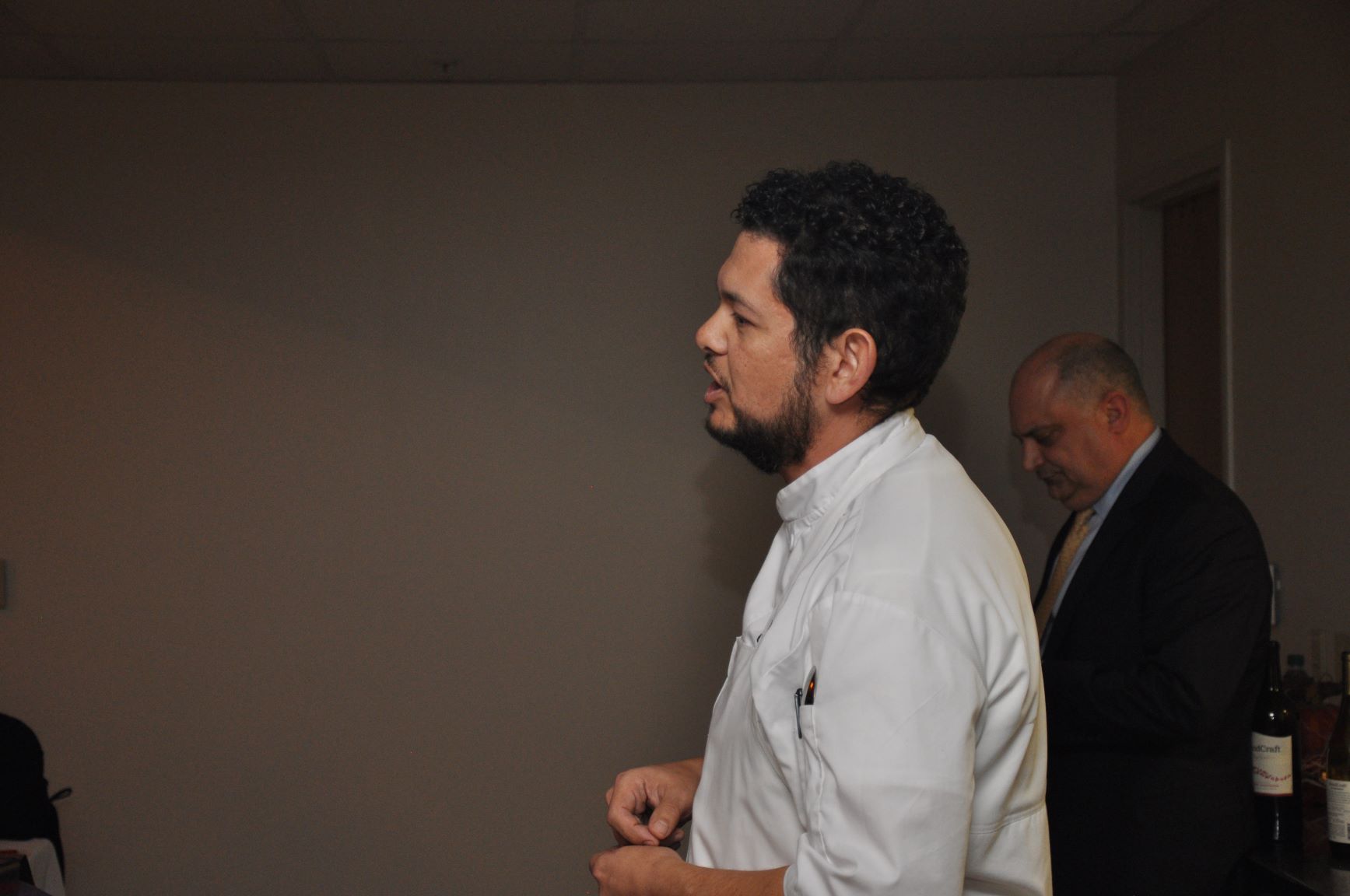By Victoria Chandler, Arkansas Made Researcher

The debut dinner for our History is Served series appropriately dove into the history, culture, and cuisine of Arkansas’s first people, the Quapaws. Gilbert Alaquinez, then executive chef of 42 Bar and Table and now executive chef of Kemuri, took inspiration from Quapaw food and table traditions, focusing on specific ingredients, prepared a modern interpretation for this dinner.
Working from research, recipes, and ingredient lists provided by the museum’s Arkansas Made research team, Chef Gilbert created a meal centered on a prominent Quapaw ingredient, the sunflower. The dinner was preceded by an intimate tour of the We Walk in Two Worlds exhibit which examines the history of the Caddo, Osage, and Quapaw in Arkansas. Special guests included members of the Quapaw Tribe of Oklahoma, including the last speaker of the Quapaw language, Ardina Moore, who offered a blessing before the meal.

Chef Gilbert Alaquinez
"I wish I could be an anthropologist,” Chef Gilbert told us. “Because by cooking I learn about that culture and I take out something and I use it in other cooking that I do in restaurants. It’s a whole process, all the homework that goes into it, and then actually cooking it and everyone enjoying it and getting a good reaction from it. That’s what got me into cooking in the first place.”
Several weeks before the dinner, the museum’s Arkansas Made team provided the chef with lists of indigenous ingredients, a few Quawpaw recipes, some historical context, and plenty of articles about traditional Quapaw foodways.
The Quapaws first appeared in historical accounts in 1673 when they encountered Father Jacques Marquette and Louis Joliet, the first French explorers in the Mississippi River Valley. Then, the tribe was living in four villages near the confluence of the Mississippi and Arkansas Rivers. Gifted horticulturalists, particularly the women, the Quapaw primarily grew beans, squash, corn – the “Three Sisters.” Corn was the main staple of the Quapaw diet. Father Marquette noted that the Quapaws produced three separate corn crops a year. They also harvested pumpkins, melons, and sunflowers, and cultivated a variety of fruits native to Arkansas – plums, persimmons, berries, and grapes. Additionally, nuts, roots, and seeds were collected. The men would hunt deer, buffalo, bear, wild turkeys, and fish. Post-contact with Europeans, peaches and chickens were raised by the tribe.
The buffalo was one of the most important animals hunted by the Quapaws. The hump and tongue were the most prized portions of meat. However, the entire animal was used – the meat was smoked, salted, or sun-dried to preserve it for later use, and the fat was rendered for other purposes. Bears were also hunted for their fat, which the Quapaws used to season their cooking.
The Quapaw creatively combined all of these ingredients into dishes noted by French colonists - “broiled venison cutlets and sun-dried bear tongues,” ground corn “seasoned plentifully with dried peaches, sometimes with turkey,” and cornbread served with fruits and smoked meats. (Arnold, Morris S. The Rumble of a Distant Drum: The Quapaws and Old World Newcomers, 1673-1804. Fayetteville: The University of Arkansas Press, 2000. 7-8.)
.png?sfvrsn=1a073733_1)
The menu of the evening reflected these early foods and traditions, including buffalo raised by current-day Quapaw members, smoked meats, seeds, and of course, corn. Chef Gilbert chose sunflowers as the predominate ingredient in the entire meal.
Members of the tribe were also able to attend which included Ardina Moore, Stephen Moore, Dixie Ramm, and Jeanne Lambert. Ms. Moore blessed the meal.
We hope it inspires you as much as it did our guests and chef.
Menu
FIRST COURSE
Cold Smoke Maple Leaf Farms Duck Breast over Hannah Farm Grist and Sunflower Seed Cake topped with Persimmon Jalapeno Preserves
SECOND COURSE
Zuni (a kind of vegetable stew or sunflower pudding)
Arkansas Sweet Corn and Charred Butternut Squash Bisque finished with Chive Oil and Sunflower Sprouts
THIRD COURSE
Cast-Iron Seared Quapaw Buffalo strip served with Caramelized Onion and Lima Bean Succotash, Honey Sweet Potato Puree then finished with Wild Mushroom Demi-Glace
FOURTH COURSE
Dark Chocolate Torte with Toasted Pecan Crumble, Cracked Pepper Blueberries, and Fresh Whipped Cream
Zuni – Sunflower Pudding – Recipe courtesy of Carrie Wilson, Ann Early, and the Arkansas Archaeological Survey
Ingredients: 6 ears worth of grated corn. Reserve the cornmilk. 1 ½ cups of finely ground roasted sunflower seeds, hulled 1 ½ cups of finely chopped summer squash 3 cups water 1 mild green chili – roasted, peeled, and finely chopped to yield ~2 tbsp
Directions: Place corn kernels, corn milk, sunflower seeds, and squash in a heavy bottomed saucepan. Add water and cover tightly. Simmer for one hour. Remove lid and continue simmering to cook off any extra water. The concoction should have the consistency of pudding. Remove from heat, season with salt if necessary. Add the chilies and serve.
